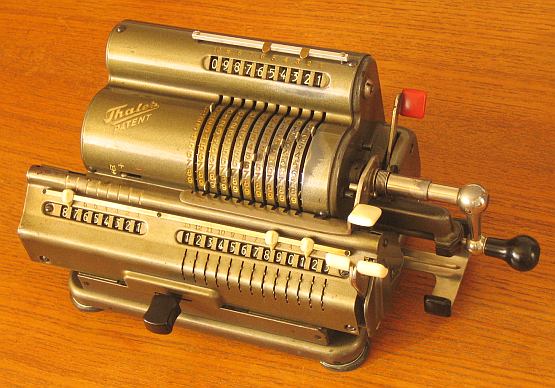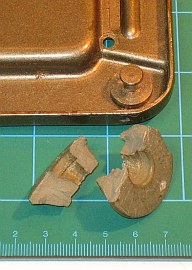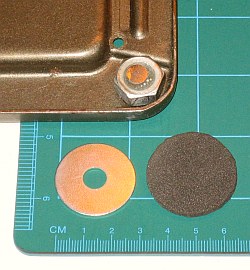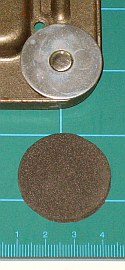previous <<==>> next
THALES - CER
 (*) Have a look at the Restoration Procedure... Have a look at the THALES GEO ... Have a look at the THALES »KA« ADDING MACHINES ... |
T E C H N I C A L D A T A of the Mechanical Calculator THALES »CER«
***************************************************************************
Serial Number: 110159
Dimensions: (ca.) Width = 11 " / 28 cm
Depth = 6_1/4" / 16 cm
Height = 5_1/2" / 14 cm
Weight: (ca.) 12_3/4 lbs / 5.8 kg
Mechanics: Pin-Wheel / Sprossenrad
10s Carry Mechanism
Functions: Add, Subtract, Multiply, Divide
Back-Transfer / Rueckuebertragung
Registers: Input = 10 Decimals
Counter = 8 Decimals
Arithmetic = 13 Decimals
Manufacturer:
THALES-WERK
Rastatt / Baden
Germany
1955
H O W T O U S E the THALES CER
**************************************
BASIC SETTINGS:
===============
(a) Crank:
----------
For addition (+) the crank is turned clockwise; for subtraction (-) the
crank is turned counter-clockwise. In the idle position the crank is DOWN
& LOCKED. To make one or more turns with the crank, pull out the handle to
unlock. When finished the turn(s), let the handle snap into lock again. The
locked down position only makes other functions (ex. clearing) accessible.
REMARK: Every started turn has to be finished completely!
Accidentally started turns are correctible somehow.
(b) Clearing Registers:
-----------------------
With the BIG LEVER on top (with white grip) the INPUT can be cleared.
(It is intended to use the thumb for).
The LEFT of the TWIN LEVERS clears the COUNTER; the RIGHT of the TWINS
clears the ARITHMETIC register.
(c) Shifting the Carriage:
--------------------------
With the 2-grip lever (located under the crank) or the big black button
(on front) the carriage can be moved one step right or one step left.
IT IS TRICKY TO MOVE THE CARRIAGE CONTINUOUSLY:
TO THE RIGHT: Take the LEFT HAND, "GRIP" the carriage together with the
black button and shift it to the right.
TO THE LEFT: Take the RIGHT HAND, "GRIP" the carriage together with the
black button and shift it to the left.
The left position "1" is the "Start Position" of the carriage.
(d) Counting Direction:
-----------------------
It depends of the 1st turn of the crank how the counter is switched to
(+) or (-). The counter will increase its content for positive (clock-
wise) or negative (counter-clockwise) turns. When the direction of the
turns is changed, the counter will decrease its content. In both cases
the counter is working with 10s-carry - and allows "Shortened Method of
Multiplication".
(e) Back Transfer:
------------------
For continuous multiplication the contents of the arithmetic unit
can be back transfered into the input register with this procedure:
(A) Clear Input Register and HOLD THE WHITE GRIP
(B) Pull the LEVER WITH THE RED GRIP against the WHITE GRIP
(C) Release both grips!
(D) Clearing the Arithmetic Unit will proceed the Back Transfer
and finally let the lever with the red grip snap back
ADDITION & SUBTRACTION:
=======================
Example: 123 + 45 - 6 = 162
Clear input, counter and arithmetic units.
ADD: Enter the first number (123) in the far right of the input unit.
Make a positive (clockwise) turn with the crank to transfer the number
into arithmetic unit. The counting unit displays the figure 1. Enter the
second number (45). Make a positive (clockwise) turn with the crank to
add the number. The arithmetic unit displays the intermediate sum (168)
and the counting unit displays the figure 2.
SUBTRACT: Enter the third number (6). Make a negative (counter-clockwise)
turn with the crank. The arithmetic unit displays the result (162) and
the counting unit is decreased by 1.
REMARK: NEGATIVE RESULTS are displayed in the arithmetic unit
as the COMPLEMENT of the next higher 10, 100, 1000, ...
Example: -12 = 99...9988
MULTIPLICATION:
===============
Example: 123 x 45 = 5535
Clear input, counter and arithmetic units.
Enter the multiplicand (123) in the far right of the input unit. The
multiplicator (45) has two digits, so the carriage is shifted to
position 2. Make positive (clockwise) turns with the crank, until the
first figure of the multiplicator (4) will appear in the 2nd position of
the counter unit. Shift the carriage to position 1. Repeat making positive
turns with the crank, until the second figure of the multiplicator (5)
appears in the 1st position of the counter unit. The multiplication is
done: The multiplicand (123) stays in the input unit, the multiplicator
(45) in the counter and the result (5535) is in the arithmetic unit.
DIVISION:
=========
Example: 22 : 7 = 3.1428571 Remainder 3
Division requires 3 steps:
(A) To Set the Divisor into Input Unit:
---------------------------------------
Enter the DIVISOR (7) in the far right of the input unit.
(B) To Set the Dividend into Arithmetic Unit:
---------------------------------------------
For the maximum number of decimals, pull out the carriage to the far
right. Set the DIVIDENT (22) into the arithmetic unit with the
affiliated toothed wheels appropriately under the divisor.
(C) To Divide:
--------------
Set the counting direction to (-). Make negative (counter-clockwise)
turns with the crank until the arithmetic unit shows an "underflow".
Make one positive (clockwise) turn with the crank. Move the carriage
to the next left position. Repeat this procedure until the required
number of decimals ...
The result (3.1428571) is in the counter unit, and the remainder (3)
is in the arithmetic unit. The divisor (7) stays in the input unit,
therefore an additional decimal can be estimated...
( 4, cause 4 x 7 = 28).
Have a look at "Calculating Trickies" ...
( * ) R E M A R K S T O R E S T O R A T I O N :
===========================================================================
The RUBBER FEET where detoriated and had to be replaced - But how ???
(1st) Big NUTS, glued around the former posts, give new foundations.
(2nd) Big WASHERS, glued on top of it, made the new bases for ...
(3rd) ... 4 NEW FEET made out of an old mouse-pad.
|


 The DecimalMarker on top was missing - Now with a "home-made" one ...
The DecimalMarker on top was missing - Now with a "home-made" one ...
